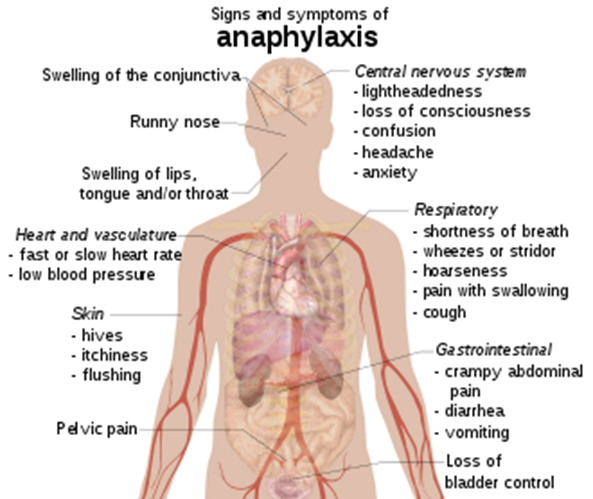A nurse is teaching a client about reducing the risk for osteoporosis. Which of the following statements by the client indicates an understanding of possible anaphylaxis?
A feeling of swelling in the feet
Pain at the injection site
A sudden decrease in heart rate
A sharp decrease in blood pressure
The Correct Answer is D
A. A feeling of swelling in the feet: Swelling in the feet can be caused by various factors such as fluid retention, circulatory issues, or certain medical conditions like venous insufficiency. It is not a typical symptom of anaphylaxis, which usually involves more generalized symptoms such as hives, itching, swelling of the face or throat, difficulty breathing, and a drop in blood pressure.
B. Pain at the injection site: Pain at the injection site is a common side effect of receiving an injection or medication. It occurs due to tissue irritation or trauma from the needle. While allergic reactions can cause localized redness, swelling, or itching at the injection site, severe pain alone is not a hallmark symptom of anaphylaxis.
C. A sudden decrease in heart rate: Anaphylaxis typically leads to an increase in heart rate (tachycardia) rather than a decrease. This increase in heart rate is a response to the body's attempt to compensate for the drop in blood pressure caused by anaphylaxis. Bradycardia (a decrease in heart rate) is not a typical feature of anaphylaxis unless it occurs very late in a severe reaction due to profound circulatory collapse.
D. A sharp decrease in blood pressure: This choice is indicative of an understanding of possible anaphylaxis. Anaphylaxis can cause a rapid and severe drop in blood pressure, known as hypotension. This drop in blood pressure is often a key feature of anaphylaxis and can lead to symptoms such as dizziness, fainting, confusion, and shock.

Nursing Test Bank
Naxlex Comprehensive Predictor Exams
Related Questions
Correct Answer is ["A","B","E"]
Explanation
A. "I will use the grab bars when getting in and out of the bathtub." - Using grab bars in the bathtub can help prevent slips and falls, promoting safety during bathing.
B. "I need to have a fire escape plan with my family." - Having a fire escape plan is crucial for emergency preparedness and can help ensure the safety of the client and their family in the event of a fire.
C. "I need to set my hot water heater to 140 degrees Fahrenheit." - Setting the hot water heater to 140 degrees Fahrenheit poses a scalding risk, especially for older adults and individuals with sensitive skin. The water heater temperature should be set to a safe and comfortable level, typically between 120 to 130 degrees Fahrenheit, to prevent burns.
D. "I will apply tape over frayed areas of electrical cords." - Applying tape over frayed areas of electrical cords is not a safe practice, as it does not address the underlying issue and may pose a fire hazard. Frayed electrical cords should be replaced promptly to prevent electrical shocks and fires.
E. "I need to check my medications for expiration dates." - Checking medication expiration dates is important to ensure that the medications remain safe and effective for use, reducing the risk of adverse effects or ineffective treatment.
Correct Answer is A
Explanation
A. Prepare the client for surgery: In emergency situations, if immediate intervention is required to save the client’s life or prevent significant harm, the principle of implied consent may apply. This means that if the client is unconscious and immediate treatment is necessary, healthcare providers may proceed with treatment under the assumption that the client would consent if able. However, this should be done in accordance with facility policies and legal guidelines.
B. Contact the facility's ethics committee for guidance: Contacting the ethics committee can be helpful for guidance on how to handle consent issues in complex situations, but it might not provide a timely solution for immediate emergency situations.
C. Keep the client stable until a family member arrives to give consent: While stabilizing the client's condition is important, waiting for a family member to arrive to give consent may not be feasible in emergency situations where immediate treatment is necessary. The nurse should seek guidance from appropriate channels to determine the best course of action.
D. Obtain consent from the surgeon: Surgeons do not have the authority to provide consent for treatment on behalf of a client who is unconscious. Consent must come from a legally authorized decision-maker, such as the client themselves if they have previously provided informed consent, or a designated healthcare proxy.
Whether you are a student looking to ace your exams or a practicing nurse seeking to enhance your expertise , our nursing education contents will empower you with the confidence and competence to make a difference in the lives of patients and become a respected leader in the healthcare field.
Visit Naxlex, invest in your future and unlock endless possibilities with our unparalleled nursing education contents today
Report Wrong Answer on the Current Question
Do you disagree with the answer? If yes, what is your expected answer? Explain.
Kindly be descriptive with the issue you are facing.
